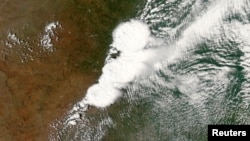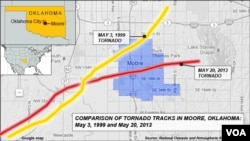Monday's deadly tornado in the central U.S. state of Oklahoma struck in an area commonly known as "Tornado Alley" - home to most of the nation's tornadoes.
Tornado Alley is generally seen to span north to south from South Dakota to Texas between the Rocky Mountains and the Appalachian Mountains, but there is no official consensus on the boundaries.
The region is susceptible to tornadoes when cold, dry air moving south from Canada meets warm, moist air from the Gulf of Mexico and warm, dry air moving east across the Rockies. The collision of warm and cold air breeds severe thunderstorms, which spawn tornadoes.
The National Weather Service's Storm Prediction Center says Tornado Alley is a nickname used by the media and stresses it only indicates the area where most tornadoes occur. It says violent or killer tornadoes happen outside Tornado Alley every year and can strike almost anywhere in the United States, as well as in Canada and overseas.
Studies have shown the deadliest twisters in the U.S. happen to the east of Tornado Alley, in an area known as "Dixie Alley." The southern state of Florida also experiences a large number of tornadoes due to its frequent thunderstorms, but they are typically weak.
Tornadoes can strike at any time, but they form most often in May and June in the late afternoon to early evening.
On May 3, 1999, Moore, Oklahoma, the town devastated by Monday's tornado, was hit by another deadly twister. It was one of more than 70 tornadoes to touch down across Oklahoma and Kansas in just 21 hours.
Tornado Alley is generally seen to span north to south from South Dakota to Texas between the Rocky Mountains and the Appalachian Mountains, but there is no official consensus on the boundaries.
The region is susceptible to tornadoes when cold, dry air moving south from Canada meets warm, moist air from the Gulf of Mexico and warm, dry air moving east across the Rockies. The collision of warm and cold air breeds severe thunderstorms, which spawn tornadoes.
The National Weather Service's Storm Prediction Center says Tornado Alley is a nickname used by the media and stresses it only indicates the area where most tornadoes occur. It says violent or killer tornadoes happen outside Tornado Alley every year and can strike almost anywhere in the United States, as well as in Canada and overseas.
Studies have shown the deadliest twisters in the U.S. happen to the east of Tornado Alley, in an area known as "Dixie Alley." The southern state of Florida also experiences a large number of tornadoes due to its frequent thunderstorms, but they are typically weak.
Tornadoes can strike at any time, but they form most often in May and June in the late afternoon to early evening.
On May 3, 1999, Moore, Oklahoma, the town devastated by Monday's tornado, was hit by another deadly twister. It was one of more than 70 tornadoes to touch down across Oklahoma and Kansas in just 21 hours.









